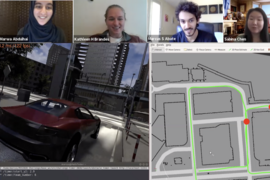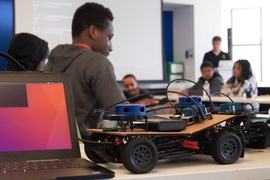On a cloudy day last August, Emily Zhang held her breath at the Hockenheimring racetrack in Germany’s Rhine Valley. Less than two weeks after the circuit hosted the German Grand Prix, it was the stage for Formula Student Germany, one of the world’s most competitive automobile design competitions for students.
Zhang and her teammates from MIT Driverless — working under the auspices of the Edgerton Center — watched anxiously as their race car rolled over to the starting line. A sleek, gleaming blue striped with white, the automobile named DUT18 wasn’t an ordinary race car. First, it was built by engineers at TU Delft; then, programmers at MIT wrote algorithms that would replace its human driver. Together, the two schools were competing for the first time in the competition’s category for autonomous — or self-driving — vehicles.
For Zhang, the competition was the test of a year’s work. A Course 6 (electrical engineering and computer science) senior and member of the Driverless computer vision team, Zhang helped write the race car’s software. Her team’s code would enable the car to attempt the competition’s various challenges, such as steering itself through a circuit it had never seen before. Two cameras mounted on the car would point at cones lining the track, then use geometry to calculate — and maintain — the car’s distance from them. For Zhang, the open-ended nature of the challenge made it an exciting change from her usual classwork. “It’s been really cool and very fun to be working on such an interesting and complex problem,” Zhang says. “And the team is great. Everyone is very passionate about working together on this problem.”
In Germany, Zhang and the other Driverless team members had one goal: getting their car to work. They certainly weren’t expecting to achieve a third-place podium finish. The success, says Driverless business team member and MBA student Krystal Liu, inspired them to aim even higher. “This year, we were planning to do it better,” she says. “This year, we were trying to go for first.”
Liu and the rest of the team would soon encounter a major challenge. After the success in Germany, the team had begun improving their software for the following year’s competition. They were about to start testing it in the Netherlands when the coronavirus pandemic struck.
“When Covid hit, we were unsure of what would happen,” Liu recalls. “Everything changed.” The team soon heard that the 2020 Formula Student Championship had been cancelled — in addition to all the other summer competitions. A while later, the team learned about a new competition being held later this year: The Indy Autonomous Challenge, or IAC, is a $1.5 million prize competition that will be held at the famed Indianapolis Motor Speedway. “It’s like the autonomous student version of the Indy 500,” Liu says.
The competition is different from the Formula Student Championship in a few ways. First, teams aren’t required to build their own cars, just the autonomous driving software — they use it to maneuver professional race cars. “It’s super high-speeds, up to 120 miles per hour,” Liu says. “So way faster than we were doing before — and still autonomous!” And for Zhang, the competition will pose the Driverless team an engineering problem they didn’t have in Germany. “We’re going to be driving with other cars,” she says. “So that’s going to bring out a lot of really cool problems.”
But even though the Driverless team is ready to take on the challenge of the IAC, participating in the competition requires funding that is difficult to come by without sponsors. Spearheading that effort is Dan Reilly, a dual-degree MBA and mechanical engineering master’s student in the Leaders for Global Operations (LGO) program. Reilly says he joined Driverless to support the team’s sponsorship strategies, and “to make sure the engineers don’t have to worry about this stuff, that they can just do the great work they do.” Over the next few months, he says, he hopes to convince companies to join hands with Driverless.
Every year, almost 40,000 Americans lose their lives in vehicular crashes. More than 90 percent of these are caused by human error, which means that autonomous vehicles could potentially save thousands of lives. Competitions like the Indy Autonomous Challenge aim to play their part by increasing public awareness of the benefits of driverless cars, as well as offering teams like MIT Driverless an opportunity to tackle the most important problems holding driverless technology back.
Liu says her time at Driverless has convinced her that autonomous technology will change the world. “I used to be uncertain about whether it would,” she says. “Now, I’m both certain that it will happen, and confident that it’s the right thing to do.”










